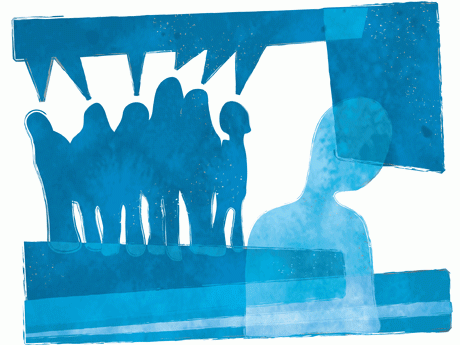Originally published on Edutopia
By Dr. Becki Cohn-Vargas, Not In Our School Director
During more than 20 years as a school administrator, I received numerous reports of bullying incidents from children, parents and teachers. Now that I’m the director of Not In Our School and bullying has become a topic of national discussion, I still regularly get calls from students and parents who share stories of tragic and worrisome incidents.
The first step in addressing any problem is to identify it, yet in the case of bullying, there is no accepted consensus on even the definition. At least ten definitions are included in various state legislatures, according to the New York Times. A new research report by the American Association of Education Researchers states, “Bullying is part of the larger phenomenon of violence in schools and communities. Educators and scholars should not limit themselves to the traditional definition. Further, the examination of victimization should involve interactions among all community members, including youth, teachers, school staff, parents, and so forth.”
We Don’t Have Time to Wait for a Definition
The challenge of defining bullying is real for researchers and for lawmakers who need the specificity in order to measure and determine the consequences of bullying. However, while that larger discussion is taking place, people in the trenches continue to face the many manifestations of bullying, social cruelty, and victimization, whether it appears in schools, colleges, workplaces, or in the community. Not In Our School takes a position that schools and communities need to come together and address bullying and intolerance. Entire schools and communities need to understand and identify both bullying and intolerance and take effective action to prevent and respond to it. Here are some suggestions and recommendations.
The Accepted Definition
Bullying is an act of verbal or physical aggression with an imbalance of power between perpetrator and victim that is repeated, or has the potential to be repeated, again and again.
Many schools use this operational definition from Dan Olweus, a researcher who has been working on the phenomenon of bullying for 40 years. An imbalance of power may allude to physical strength, access to embarrassing information, or popularity that is used to try to control or harm others. However, power imbalances can change over time and in different situations, even if the imbalances involve the same people.
Eating Alone in the Cafeteria
Relational bullying is manifested through exclusion, spreading of rumors and social isolation. It often occurs among students who are trying to raise their social status by rejecting someone from their group. This form of bullying can be more subtle and is also much harder to address both from a response and research perspective. Yet it can be just as devastating, and often goes unaddressed over years resulting in damage across a lifetime.
“That’ so gay.” “That’s so Jewish.”
Along with bullying, intolerance is often at the heart of victimization. Intolerance is often revealed through unkind remarks with stereotypical comments regarding a person’s identity, such as their race, ethnicity, language, sexual orientation, religion, or physical ability. These intolerant attitudes can be developed and/or supported via the attitudes, actions and behaviors—sometimes conscious and sometimes not—of peers, family, teachers, coaches, or other individuals in a child’s life, but also through the media, music and the Internet. Students may express intolerance toward others overtly in a classroom or public setting, but this also often occurs in venues where adults are not even aware it is taking place.
Intolerance is often embedded in institutional practices. Some examples of systemic intolerance and institutionalized racism include the disproportionate number of African American or Latino students who are suspended and expelled or when the academic proficiency standards for certain ethnic groups are lower than others, as is true in Florida and Virginia. That tacit acceptance of racially biased systemic initiatives creates a climate for interpersonal intolerance of all types to flourish.

Although incidences of bullying and harassment sometimes overlap, not all bullying is harassment and not all harassment is bullying. Under federal civil rights laws, harassment is “unwelcome conduct based on a protected class (race, national origin, color, sex, age, disability, religion) that is severe, pervasive, or persistent and creates a hostile environment.” Bullying behaviors may include harassment, but not always. However, both bullying and harassment are both considered forms of victimization.
Preventing Victimization, Bullying and Intolerance is a Process
The all-too-common practice of holding a moving schoolwide assembly or community event about the devastating impact of bullying is not enough to prevent bullying; nor will things change by simply explaining or posting the rules, laws, and policies. Change comes through an ongoing focus of creating a welcoming environment with regular dialogue about these issues where all voices are heard. Here are a few key ideas for reducing bullying and creating that positive climate in schools, workplaces and all social venues:
1. Involve the whole community, whether it is a school site, church, neighborhood or town, in creating a shared vision for a positive climate with clear expectations for behavior.
2. Use surveys to regularly assess the “climate” or sense of belonging and the way people feel on campus or in the workplace and monitor progress.
3. For youth, include the teaching of positive social skills together with bullying prevention and intervention strategies as part of the curriculum at all grade-levels and re-teach as needed during a moment of intervening in small and large incidents.
4. Teach all members of a community to be “upstanders,” those who speak up and stand up for themselves and others.
5. Engage in regular dialogue about issues of bullying and intolerance, and create opportunities to bridge differences, create empathy, and learn about various backgrounds and cultures.
Bottom line: It is Important to Address All Forms of Victimization
Taking action means both preventing and responding to victimization incidents, whether they stem from acts of bullying, intolerance, or any form of social cruelty. An effective action plan includes the whole community working in a sustained manner to change the climate to one that is caring and empathetic.
Create an anti-bullying campaign on your campus with the Not In Our School Quick Start Guide.